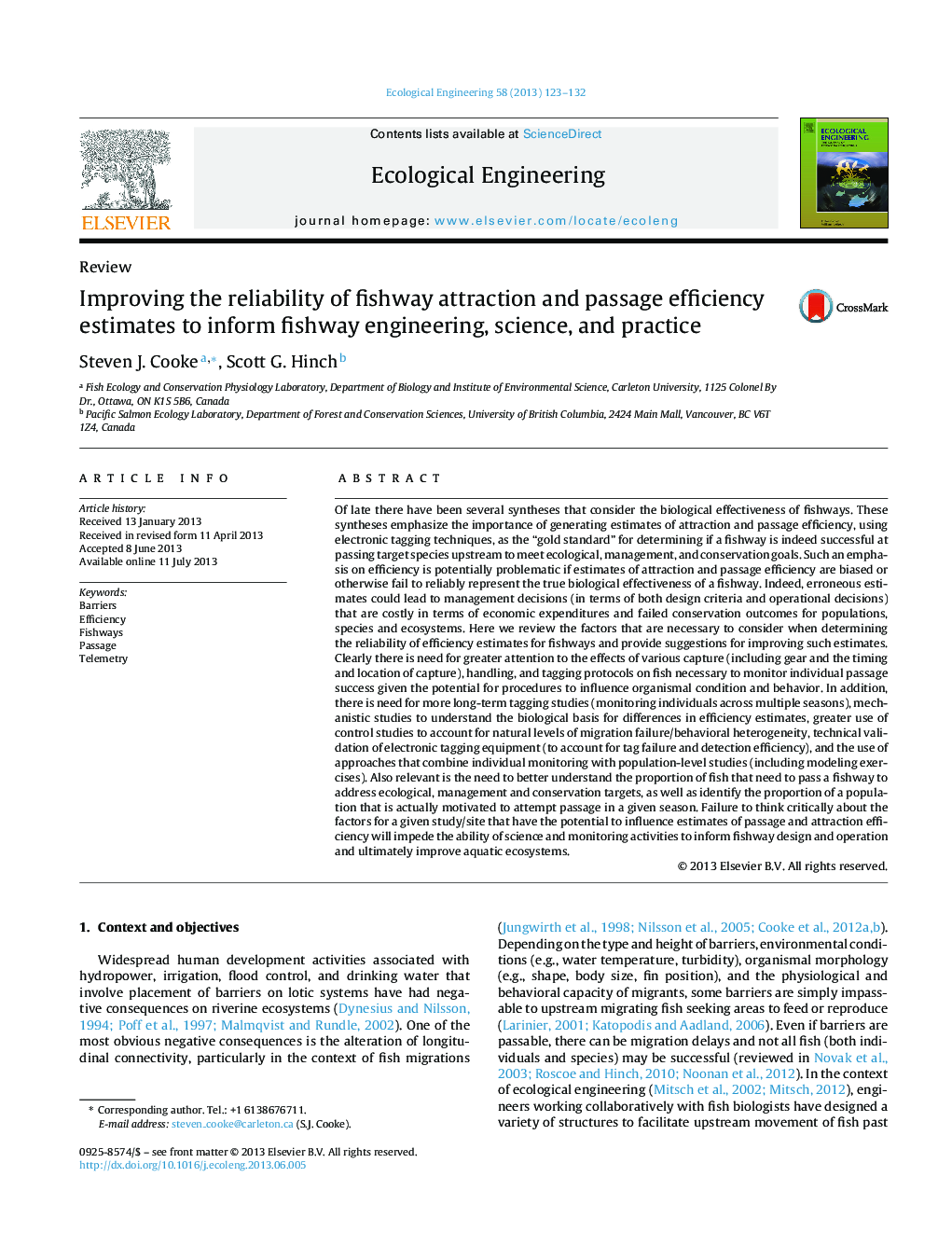| کد مقاله | کد نشریه | سال انتشار | مقاله انگلیسی | نسخه تمام متن |
|---|---|---|---|---|
| 6302493 | 1618040 | 2013 | 10 صفحه PDF | دانلود رایگان |
عنوان انگلیسی مقاله ISI
Improving the reliability of fishway attraction and passage efficiency estimates to inform fishway engineering, science, and practice
ترجمه فارسی عنوان
بهبود قابلیت اطمینان جذب ماهیانه و برآورد هزینه های عبور برای اطلاع از مهندسی ماهی، مهندسی، و تمرین
دانلود مقاله + سفارش ترجمه
دانلود مقاله ISI انگلیسی
رایگان برای ایرانیان
کلمات کلیدی
ترجمه چکیده
از اواخر چندین سنتز وجود دارد که اثرات بیولوژیکی ماهیان را در نظر می گیرند. این سنتز تاکید بر اهمیت تولید برآوردهای جذابیت و راندمان عبور، با استفاده از تکنیک های برچسب زدن الکترونیکی، به عنوان استاندارد استاندارد طلا؟ برای تعیین اینکه آیا یک ماهی ماهی در واقع موفق به عبور از گونه های هدف بالادست برای دیدار با اهداف زیست محیطی، مدیریت و حفاظت. چنین تأکیدی بر کارایی بالقوه مشکل ساز است اگر برآوردهای جذابیت و راندمان عبور از تعصب و یا در غیر اینصورت به طور قابل اعتماد نشان دهنده اثربخشی بیولوژیکی واقعی ماهیچه باشد. در واقع، تخمین های اشتباه می تواند به تصمیمات مدیریتی (از نظر معیارهای طراحی و تصمیمات عملیاتی) منجر شود که از نظر هزینه های اقتصادی و نتایج حفاظت از ذخیره سازی برای جمعیت ها، گونه ها و اکوسیستم ها پرهزینه است. در اینجا فاکتورهای مورد نیاز برای تعیین اعتبار برآوردهای بهره وری برای جاده های ماهی مورد بررسی قرار می گیریم و پیشنهاداتی را برای بهبود چنین برآوردها ارائه می دهیم. واضح است که نیاز به توجه بیشتر به اثرات ضبط مختلف (از جمله چرخ دنده ها و زمان بندی و محل ضبط)، دست زدن و برچسب زدن پروتکل ها در ماهی لازم است برای نظارت بر موفقیت گذراندن فرد با توجه به پتانسیل رویه برای تاثیر بر وضعیت و رفتار سازمانی. علاوه بر این، مطالعات بیشتری در زمینه برچسب زدن طولانی مدت (نظارت بر افراد در چندین فصل)، مطالعات مکانیستی برای درک مبانی بیولوژیکی برای تفاوت در ارزیابی کارآیی، استفاده بیشتر از مطالعات کنترل برای تعیین سطح طبیعی ناهمگونی رفتاری / مهاجرت اعتبار سنجی فنی تجهیزات برچسب زدن الکترونیکی (برای تشخیص شکست ترافیک و بازده تشخیص) و استفاده از رویکردهایی که مانیتورینگ فردی را با مطالعات سطح جمعیت (از جمله تمرینات مدل سازی) ترکیب می کند. همچنین نیاز به درک بهتر نسبت ماهی که نیاز به گذر از ماهی رودخانه برای رسیدگی به اهداف زیست محیطی، مدیریت و حفاظت، و همچنین شناسایی نسبت جمعیت است که واقعا انگیزه برای عبور در یک فصل خاص است. عدم شناختن انتقادی از عوامل مربوط به یک مطالعه / سایت خاص که توانایی تاثیرگذاری بر برآوردهای بهره وری و جذب را دارد، مانع توانایی فعالیت های علمی و نظارت شده برای اطلاع از طراحی و عملیات ماهیانه و در نهایت بهبود اکوسیستم های آبزی خواهد شد.
موضوعات مرتبط
علوم زیستی و بیوفناوری
علوم کشاورزی و بیولوژیک
بوم شناسی، تکامل، رفتار و سامانه شناسی
چکیده انگلیسی
Of late there have been several syntheses that consider the biological effectiveness of fishways. These syntheses emphasize the importance of generating estimates of attraction and passage efficiency, using electronic tagging techniques, as the “gold standard” for determining if a fishway is indeed successful at passing target species upstream to meet ecological, management, and conservation goals. Such an emphasis on efficiency is potentially problematic if estimates of attraction and passage efficiency are biased or otherwise fail to reliably represent the true biological effectiveness of a fishway. Indeed, erroneous estimates could lead to management decisions (in terms of both design criteria and operational decisions) that are costly in terms of economic expenditures and failed conservation outcomes for populations, species and ecosystems. Here we review the factors that are necessary to consider when determining the reliability of efficiency estimates for fishways and provide suggestions for improving such estimates. Clearly there is need for greater attention to the effects of various capture (including gear and the timing and location of capture), handling, and tagging protocols on fish necessary to monitor individual passage success given the potential for procedures to influence organismal condition and behavior. In addition, there is need for more long-term tagging studies (monitoring individuals across multiple seasons), mechanistic studies to understand the biological basis for differences in efficiency estimates, greater use of control studies to account for natural levels of migration failure/behavioral heterogeneity, technical validation of electronic tagging equipment (to account for tag failure and detection efficiency), and the use of approaches that combine individual monitoring with population-level studies (including modeling exercises). Also relevant is the need to better understand the proportion of fish that need to pass a fishway to address ecological, management and conservation targets, as well as identify the proportion of a population that is actually motivated to attempt passage in a given season. Failure to think critically about the factors for a given study/site that have the potential to influence estimates of passage and attraction efficiency will impede the ability of science and monitoring activities to inform fishway design and operation and ultimately improve aquatic ecosystems.
ناشر
Database: Elsevier - ScienceDirect (ساینس دایرکت)
Journal: Ecological Engineering - Volume 58, September 2013, Pages 123-132
Journal: Ecological Engineering - Volume 58, September 2013, Pages 123-132
نویسندگان
Steven J. Cooke, Scott G. Hinch,
